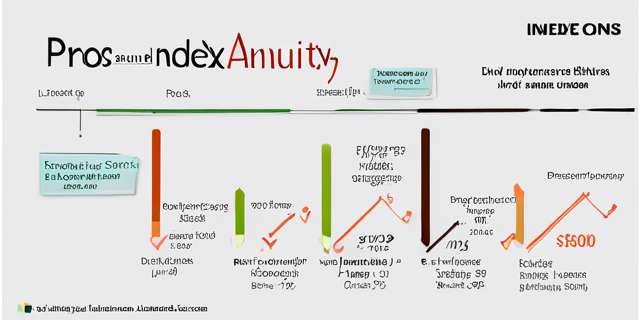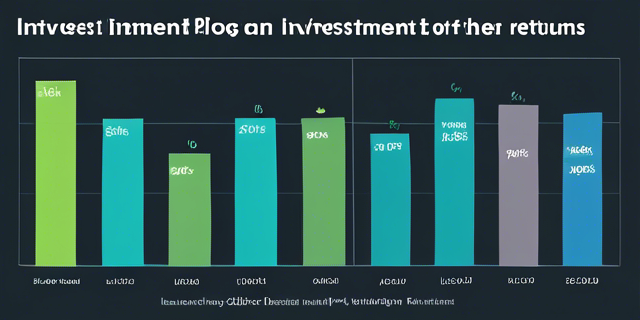Building an Investment Portfolio from Scratch 2024: A Beginner’s Guide

So, you’ve finally decided to take control of your financial future and start investing? Congratulations! Building an investment portfolio from scratch might seem like a daunting task, but it doesn’t have to be. With a little guidance and the right mindset, you can embark on this exciting journey and set yourself up for long-term financial success.
Why Building an Investment Portfolio is Crucial
Before we dive into the nitty-gritty of portfolio construction, let’s address the elephant in the room: why is it so important to build an investment portfolio in the first place? Well, my friend, the answer is simple – to grow your wealth and secure your financial future.
Think about it this way: if you’re relying solely on your income, you’re essentially trading your time for money. But what happens when you can no longer work or when your income doesn’t keep up with inflation? That’s where your investment portfolio comes into play. By investing your money wisely, you’re allowing it to work for you, potentially generating returns that can supplement your income and help you achieve your financial goals, whether it’s a comfortable retirement, funding your children’s education, or simply having a financial cushion for rainy days.
Understanding Your Investment Objectives
Before you start building your portfolio, it’s crucial to understand your investment objectives. Are you investing for retirement, a down payment on a house, or something else entirely? Your investment objectives will dictate the types of investments you choose, your risk tolerance, and your time horizon.
For example, if you’re investing for retirement, which is typically a long-term goal, you may be more inclined to take on slightly more risk in pursuit of higher returns. On the other hand, if you’re saving for a down payment on a house in the next few years, you’ll likely want to prioritize capital preservation over growth, opting for more conservative investments.
Determining Your Risk Tolerance

Speaking of risk, it’s essential to determine your risk tolerance before diving into the world of investing. Risk tolerance refers to your ability and willingness to stomach market fluctuations and potential losses. Generally, the higher the potential return, the higher the risk associated with an investment.
Some factors that can influence your risk tolerance include your age, investment timeline, financial situation, and personality. For instance, if you’re in your 20s or 30s with a stable income and no significant financial obligations, you may be able to take on more risk than someone nearing retirement with limited income sources.
There’s no one-size-fits-all approach to risk tolerance, but it’s crucial to be honest with yourself about how much risk you’re comfortable taking on. After all, you don’t want to lose sleep over market volatility or make rash decisions based on fear or greed.
H2: Building Your Investment Portfolio: A Step-by-Step Guide
Now that you have a better understanding of your investment objectives and risk tolerance, let’s dive into the actual process of building your investment portfolio.
Step 1: Decide on Your Investment Account
The first step in building your portfolio is deciding on the type of investment account you’ll be using. The most common options include:
- Employer-sponsored retirement accounts (e.g., 401(k), 403(b))
- Individual retirement accounts (IRAs, including traditional and Roth)
- Taxable brokerage accounts
Each account type has its own rules, tax implications, and contribution limits, so it’s important to understand the differences and choose the one that best fits your needs. For example, if you’re investing for retirement, an employer-sponsored account or IRA might be the way to go, as they offer tax advantages. If you’re investing for a shorter-term goal, a taxable brokerage account could be more suitable.
Step 2: Choose Your Asset Allocation
Asset allocation is the process of dividing your investment portfolio among different asset classes, such as stocks, bonds, real estate, and cash or cash equivalents. This is arguably one of the most critical steps in building your portfolio, as it will largely determine your overall risk and potential returns.
A common rule of thumb is to subtract your age from 110 (or 120 for more conservative investors) to determine the percentage of your portfolio that should be allocated to stocks. The remainder would be allocated to bonds and other fixed-income investments. For example, if you’re 30 years old, you might consider allocating 80% (110 – 30) of your portfolio to stocks and 20% to bonds.
However, this is just a general guideline, and your actual asset allocation should be tailored to your specific investment objectives, risk tolerance, and time horizon. Additionally, you may want to consider diversifying further by including alternative investments, such as real estate investment trusts (REITs) or commodities.
Step 3: Choose Your Investments
Once you’ve determined your asset allocation, it’s time to choose the specific investments that will make up your portfolio. Here are some common investment options:
- Stocks: You can invest in individual stocks or opt for stock mutual funds or exchange-traded funds (ETFs) for instant diversification.
- Bonds: Consider government bonds, corporate bonds, or bond funds for fixed-income exposure.
- Real estate: REITs and real estate crowdfunding platforms can provide exposure to the real estate market without the hassle of direct property ownership.
- Alternative investments: Options include commodities, hedge funds, and private equity, though these may be more suitable for experienced investors.
When selecting investments, it’s essential to consider factors such as fees, past performance, and the underlying assets or strategies. Don’t just chase after the hottest investments or blindly follow the herd – do your research and understand what you’re investing in.
Step 4: Implement and Monitor Your Portfolio
After you’ve chosen your investments, it’s time to implement your investment plan and start building your portfolio. This may involve setting up automatic contributions or making lump-sum investments, depending on your situation.
However, your work doesn’t end there. Successful investing requires ongoing monitoring and rebalancing to ensure that your portfolio stays aligned with your investment objectives and risk tolerance. This may involve periodically adjusting your asset allocation or selling underperforming investments and reallocating the proceeds.
It’s also important to stay up-to-date with market conditions and economic trends, as these can impact your investment decisions. Consider seeking the guidance of a financial advisor, especially if you’re new to investing or have a complex financial situation.
Diversification: The Key to Reducing Risk

As you embark on your investment journey, you’ll likely encounter the term “diversification” time and time again. But what exactly does it mean, and why is it so important?
Diversification is the practice of spreading your investments across different asset classes, sectors, and geographic regions. By diversifying your portfolio, you’re essentially not putting all your eggs in one basket, which can help mitigate the impact of any single investment’s underperformance or market downturn.
Here are a few ways to diversify your portfolio:
- Asset class diversification: Invest in a mix of stocks, bonds, real estate, and other asset classes to reduce overall portfolio risk.
- Geographic diversification: Consider investing in both domestic and international markets to capture potential growth opportunities worldwide.
- Sector diversification: Spread your investments across different industries and sectors to reduce the impact of industry-specific risks.
- Investment style diversification: Include a combination of growth and value investments, as well as small-cap and large-cap stocks.
It’s important to note that diversification alone does not guarantee a profit or protect against losses, but it can be an effective risk management strategy when used appropriately.
Tax-Efficient Investing Strategies
While building wealth through investing is undoubtedly exciting, it’s essential to consider the tax implications of your investment decisions. After all, you don’t want Uncle Sam taking a bigger bite out of your hard-earned returns than necessary.
Here are some tax-efficient investing strategies to consider:

Tax-Advantaged Accounts
One of the most effective ways to minimize your tax burden is to utilize tax-advantaged accounts, such as 401(k)s, IRAs, and health savings accounts (HSAs). These accounts offer various tax benefits, such as tax-deferred growth (traditional accounts) or tax-free growth and withdrawals (Roth accounts).
By contributing to these accounts, you can potentially reduce your taxable income and allow your investments to grow more efficiently over time. Just be sure to familiarize yourself with the contribution limits, withdrawal rules, and other guidelines to avoid costly penalties.
Tax-Loss Harvesting
Tax-loss harvesting is a strategy that involves selling investments that have experienced losses to offset capital gains from other investments. This can help reduce your overall tax liability and potentially lower your tax bracket.
For example, let’s say you have a stock that has lost value and a mutual fund that has generated substantial gains. By selling the losing stock, you can use those losses to offset the gains from the mutual fund, thereby reducing the amount
Tax-Loss Harvesting
Tax-loss harvesting is a strategy that involves selling investments that have experienced losses to offset capital gains from other investments. This can help reduce your overall tax liability and potentially lower your tax bracket.
For example, let’s say you have a stock that has lost value and a mutual fund that has generated substantial gains. By selling the losing stock, you can use those losses to offset the gains from the mutual fund, thereby reducing the amount of taxes you’ll owe on those gains.
However, it’s important to be mindful of the wash sale rule, which prohibits you from claiming a loss if you repurchase the same or a substantially identical investment within 30 days before or after the sale. This could invalidate the tax loss, so it’s essential to plan your transactions carefully.
Asset Location
Asset location is the practice of strategically placing different types of investments in various accounts based on their tax efficiency. The goal is to maximize your after-tax returns by holding tax-efficient investments in taxable accounts and tax-inefficient investments in tax-advantaged accounts.
For example, you might hold investments that generate a lot of taxable income, such as bonds or REITs, in your tax-deferred accounts like IRAs or 401(k)s. On the other hand, you could place more tax-efficient investments, like growth stocks or tax-managed funds, in your taxable brokerage account.
By implementing an effective asset location strategy, you can potentially minimize the drag of taxes on your investment returns and keep more of your hard-earned money working for you.
Rebalancing Your Portfolio: A Necessary Maintenance Task
As you navigate the investment landscape, you’ll inevitably encounter market fluctuations and shifts in your personal circumstances. This is where rebalancing your portfolio comes into play – a crucial maintenance task that helps ensure your investments remain aligned with your goals and risk tolerance.
What is Rebalancing?
Rebalancing is the process of periodically adjusting the weightings of the different asset classes in your portfolio to match your desired asset allocation. Over time, as some investments outperform others, your portfolio’s asset allocation can drift away from its original target, potentially exposing you to more or less risk than you’re comfortable with.
By rebalancing, you’re essentially selling a portion of your overweight assets and using the proceeds to purchase underweight assets, bringing your portfolio back in line with your desired allocation.
Why Rebalance?
Rebalancing serves several important purposes:
- Risk management: By maintaining your desired asset allocation, you’re ensuring that your portfolio’s risk profile remains consistent with your risk tolerance.
- Profit-taking: Rebalancing forces you to sell a portion of your winners, which can help lock in gains and prevent any one investment from dominating your portfolio.
- Buying low and selling high: When you rebalance, you’re essentially selling assets that have appreciated in value (high) and buying assets that have declined in value (low), which aligns with the fundamental investing principle of buying low and selling high.
- Emotional discipline: Rebalancing helps remove emotion from the investing process by providing a systematic approach to buying and selling, preventing you from making rash decisions based on fear or greed.
Rebalancing Strategies
There are a few different approaches to rebalancing your portfolio:
- Calendar-based rebalancing: This involves rebalancing your portfolio on a predetermined schedule, such as annually, quarterly, or monthly.
- Percentage-based rebalancing: With this method, you rebalance your portfolio whenever an asset class deviates from its target allocation by a predetermined percentage, such as 5% or 10%.
- Hybrid approach: You can also combine calendar-based and percentage-based rebalancing, allowing you to take advantage of the benefits of both strategies.
The optimal rebalancing strategy will depend on your individual circumstances, investment objectives, and personal preferences. Some investors may prefer a more hands-off approach, while others may want to be more actively involved in the rebalancing process.
Seeking Professional Guidance: When to Consult a Financial Advisor
While it’s certainly possible to build and manage an investment portfolio on your own, there may come a time when seeking professional guidance from a financial advisor becomes advisable or even necessary.
Here are a few scenarios where consulting a financial advisor could be beneficial:
You Have a Complex Financial Situation
If you have a particularly complex financial situation, such as owning a business, managing a significant inheritance, or navigating divorce or estate planning, a financial advisor can provide valuable expertise and guidance tailored to your unique circumstances.
You’re Approaching a Major Life Event
Major life events, such as retirement, a job change, or the birth of a child, can significantly impact your financial situation and investment needs. A financial advisor can help you navigate these transitions and adjust your investment strategy accordingly.
You Lack the Time or Expertise
Investing and managing a portfolio can be time-consuming and requires a certain level of knowledge and expertise. If you’re short on time or simply don’t feel comfortable making investment decisions on your own, enlisting the help of a professional can be a wise choice.
You Need Objective Guidance
It’s easy to let emotions like fear, greed, or overconfidence cloud your investment judgment. A financial advisor can provide objective, unbiased guidance, helping you make rational decisions based on your goals and risk tolerance, rather than emotions.
You Want a Comprehensive Financial Plan
While this article focuses on building an investment portfolio, a financial advisor can also help you develop a comprehensive financial plan that encompasses various aspects of your financial life, such as retirement planning, tax strategies, estate planning, and insurance needs.
When selecting a financial advisor, it’s important to do your due diligence. Look for someone who is a certified financial planner (CFP) or holds other relevant credentials, has experience working with clients in similar situations, and adheres to a fiduciary standard, meaning they are legally obligated to act in your best interests.
Conclusion
Building an investment portfolio from scratch may seem daunting, but it’s a journey worth taking. By following the steps outlined in this guide, understanding the importance of diversification and tax-efficient investing, and implementing a regular rebalancing strategy, you’ll be well on your way to achieving your financial goals.
Remember, investing is a long-term endeavor, and success requires patience, discipline, and a willingness to continuously learn and adapt. Don’t be afraid to seek professional guidance when needed, and always keep your investment objectives and risk tolerance at the forefront of your decision-making process.
With dedication and a sound investment strategy, you can harness the power of compounding returns and build a portfolio that not only serves your financial needs but also provides peace of mind and a sense of control over your financial future.
FAQ:
Q1: What is the minimum amount needed to start investing?
There’s no definitive minimum amount required to start investing, as different investment vehicles and platforms have varying minimum investment requirements. However, even if you have a relatively small amount to invest, you can still get started through options like low-cost index funds, robo-advisors, or micro-investing apps.
Q2: How often should I rebalance my portfolio?
The frequency of rebalancing depends on your chosen strategy and personal preferences. Some investors rebalance annually or quarterly, while others do so when their asset allocation deviates from their target by a predetermined percentage (e.g., 5% or 10%).
Q3: Is it better to invest in individual stocks or mutual funds/ETFs?
There is no one-size-fits-all answer to this question. Individual stocks can potentially offer higher returns but also carry higher risk. Mutual funds and ETFs provide instant diversification but may have higher fees and lower potential returns. The choice depends on your investment goals, risk tolerance, and level of expertise.
Q4: How do I know if I need a financial advisor?
If you have a complex financial situation, are approaching a major life event, lack the time or expertise to manage your investments, or simply want objective guidance and a comprehensive financial plan, consulting a financial advisor could be beneficial.
Q5: What are some common investment mistakes to avoid?
Some common investment mistakes include failing to diversify, chasing past performance, letting emotions like fear or greed influence your decisions, not rebalancing your portfolio, and neglecting to consider tax implications. Educating yourself and seeking professional guidance when needed can help you avoid these pitfalls.









